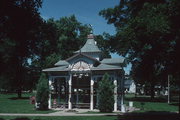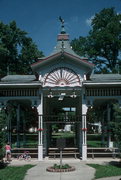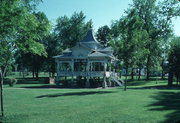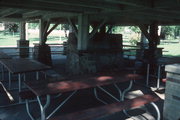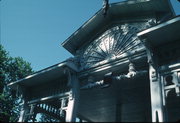Property Record
SWAN PARK AT NW CNR OF S UNIVERSITY ST AND E SOUTH ST
Architecture and History Inventory
| Historic Name: | (George E. and Mary) Swan House and Vita Spring Pavilion |
|---|---|
| Other Name: | Vita Spring Pavilion |
| Contributing: | |
| Reference Number: | 15131 |
| Location (Address): | SWAN PARK AT NW CNR OF S UNIVERSITY ST AND E SOUTH ST |
|---|---|
| County: | Dodge |
| City: | Beaver Dam |
| Township/Village: | |
| Unincorporated Community: | |
| Town: | |
| Range: | |
| Direction: | |
| Section: | |
| Quarter Section: | |
| Quarter/Quarter Section: |
| Year Built: | 1880 |
|---|---|
| Additions: | |
| Survey Date: | 1974 |
| Historic Use: | park shelter/building |
| Architectural Style: | Queen Anne |
| Structural System: | |
| Wall Material: | Wood |
| Architect: | |
| Other Buildings On Site: | |
| Demolished?: | No |
| Demolished Date: |
| National/State Register Listing Name: | Swan House and Vita Spring Pavilion |
|---|---|
| National Register Listing Date: | 4/9/1980 |
| State Register Listing Date: | 1/1/1989 |
| National Register Multiple Property Name: |
| Additional Information: | A 'site file' (Swan House and Vita Spring Pavilion) exists for this property. It contains additional information such as correspondence, newspaper clippings, or historical information. It is a public record and may be viewed in person at the State Historical Society, Division of Historic Preservation. During summers in the late nineteenth century, wealthy Americans flocked to fashionable spas. “Taking the waters"--drinking from mineral springs or bathing in them--was supposed to improve one’s health, but vacationers also came to relax away from cities and participate in genteel social activities such as open-air concerts and formal balls. Wisconsin's spas were never as prestigious as such leading resorts as New York's Saratoga Springs, but they drew many health- and pleasure-seekers. In 1880, homeopath George Swan opened Vita Park, using the Latin word for "life." He claimed its spring water could relieve kidney, bladder, and urethra ailments. Working with a Chicago landscape architect, he turned a former cow pasture into an idyllic park, complete with a four-story hotel, croquet grounds, tennis courts, ponds for boating and bathing, and winding paths shaded by ivy arbors and thousands of trees. Guests could lounge on the hotel verandas or gaze at the grounds from the hotel observatories. There were also bathhouses, a greenhouse, "air castles" in trees reached by winding stairs, and a band shell for concerts. And of course there was the spring itself, sheltered under an elegant canopy. Though Swan's resort flourished in the early 1890s--it was especially popular with health-seekers and those fleeing yellow fever in St. Louis, New Orleans, and Louisville--it never proved profitable, and the hotel closed in 1893. The only surviving structure is the Queen Anne style canopy that covered the spring (capped in 1905). The little pavilion is decked out with elaborate Eastlake decorations (also see WL14). Spindle friezes run beneath the eaves, spindle finials terminate the gables, wooden appliqués make the columns look like bedposts, and wooden sunbursts brighten the gable ends. The roof comprises a pyramidal base, cross gables, and a square belvedere, crowned by a bracketed mansard roof, which provides a perch for a cast-iron eagle. In the early twentieth century, the city acquired the resort grounds and converted the property into a public park. Recently the city carefully restored the pavilion. George Swan's Queen Anne style house, which boasts a cone-roofed turret, still stands nearby at the northwest corner of Park and North Vita avenues. BUILT BY DR. G.E. SWAN OVER A NATURAL SPRING THOUGHT TO HAVE HEALING POWERS. PAVILION WAS CENTER OF VITA MINERAL SPRING RESORT CA 1880-1893. WATER COLLECTED IN MARBLE BASIN W/WAUKESHA FLAGSTONE SURROUND. SPRING CAPPED AND BASIN AND SERVING COUNTERS REMOVED. |
|---|---|
| Bibliographic References: | BEAVER DAM DAILY CITIZEN 8/1/1995. Buildings of Wisconsin manuscript. |
| Wisconsin Architecture and History Inventory, State Historic Preservation Office, Wisconsin Historical Society, Madison, Wisconsin |

